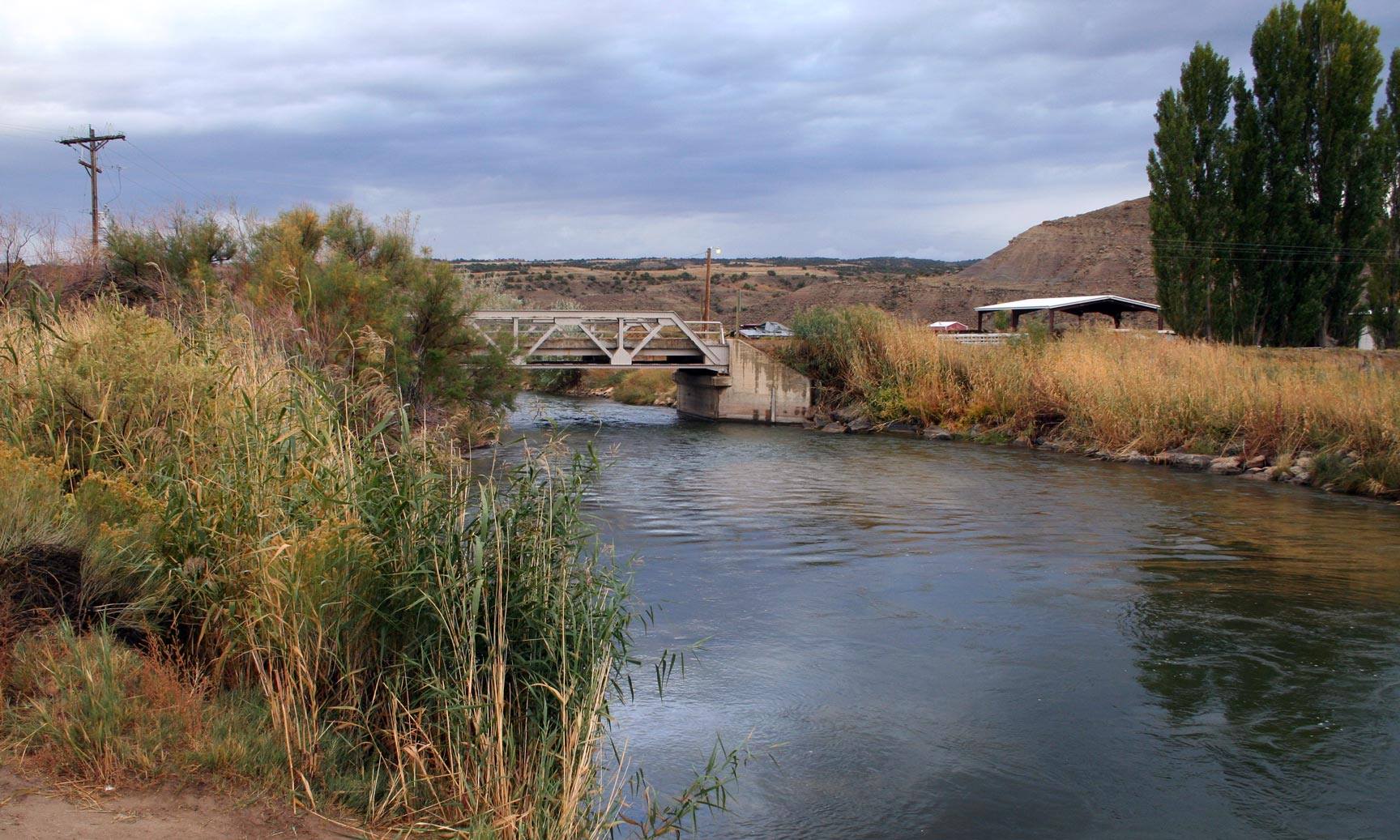by Deep Green Resistance News Service | Jan 13, 2018 | Biodiversity & Habitat Destruction
Editor’s note: On January 8, 2018, a federal judge dismissed US government’s criminal charges against Nevada rancher Cliven Bundy, two of his sons and another man linked to militia groups, over procedural errors made by the prosecution. This is a history of the Bundy grazing allotment.
by Center for Biological Diversity
• The Bundy family began grazing on federal public lands near Gold Butte, Nevada, in 1954 – lands located in the recently designated Gold Butte National Monument – some of the driest and most fragile desert in North America.
• In 1973 the Bundys were granted their first federal grazing permit. Given the aridity and fragility of the desert, the Bureau of Land Management (BLM) issued a permit for grazing in this ephemeral range, which is subject to environmental and other conditions. Ephemeral range in the southwest desert region does not consistently produce forage for grazing.
• In 1989 the desert tortoise was granted protection under the federal Endangered Species Act because of widespread destruction of its fragile desert habitat by livestock grazing, urbanization and other factors.
• In 1991, the U.S. and Fish and Wildlife Service (FWS) issued a draft Biological Opinion (BO) governing the management of desert tortoise habitat. The BLM developed a timetable to meet its requirements and shared the requirements and timetable with permittees, including Cliven Bundy, whose cattle grazed in tortoise habitat. The BLM requested and FWS then agreed to delay implementation of the BO until 1993.
• On February 26th, 1993, Cliven Bundy sent two “Administrative Notices of Intent” to the BLM asserting that the BLM has no legal jurisdiction over federal public lands, and stating his intent to graze cattle, “pursuant to my vested grazing rights.” Bundy stopped paying his grazing fees after February 28th of 1993.
• The BLM sent Bundy a notice that his request for a grazing application had not been received and requested that he re-submit within one week or BLM action would be taken.
• On July 13, 1993, BLM sent Bundy a Trespass Notice and Order to Remove which set a timeline for cattle removal given his non-payment of fees. Later BLM extended the timetable at Bundy’s request.
• On September 30, 1993, the Nevada State BLM Director requested injunctive relief—action from the court—to address Bundy’s unlawful cattle grazing.
• On January 24, 1994 BLM tried to deliver to Bundy a proposed decision to cancel his permit, request payment of trespass damages, and order the removal of trespass livestock. When BLM delivered the notice, Bundy’s son tore up the document. The torn document was recovered and used as evidence of illegal grazing by the BLM in court.
• On March 3, 1994, Cliven Bundy, given his refusal to recognize federal authority to own and administer federal lands, sent payment for his grazing permit to Clark County instead of the BLM. The county refused Bundy’s payment for lack of jurisdiction.
• In 1998, the U.S. Attorney filed suit requesting that the federal district court order Bundy to remove his cattle and pay outstanding grazing fees and fines totaling now more than $150,000.
• In October 1998, the BLM approved a new Resource Management Plan for the Las Vegas Field Office. The plan allowed for the closure of grazing allotments in critical tortoise habitats, including the Bunkerville allotment.
• On November 3, 1998, United States District Judge Johnnie Rawlinson permanently enjoined Bundy from grazing his livestock within the Bunkerville allotment. Rawlinson assessed fines against Bundy, affirmed federal authority over federal land, and wrote that “[t]he government has shown commendable restraint in allowing this trespass to continue for so long without impounding Bundy’s livestock.” Cite.
• Bundy refused to comply with the order. He filed an emergency motion for stay to try and halt the court ruling while he appealed the case to the Ninth Circuit Court.
• On May 14th, 1999, the Ninth Circuit Court denied Bundy’s appeal and upheld the district court decision ordering the removal of Bundy’s cattle from the Bunkerville allotment. Cite.
• On September 17th, 1999, after Bundy refused to comply with the court’s earlier orders, the Federal District Court again ordered Bundy to comply with the earlier permanent injunction and assessed additional fines.
• In December 1998, in order to mitigate harm to desert tortoise from urban sprawl, Clark County purchased the federal grazing permit to the Bunkerville Allotment for $375,000. The county retired the allotment to protect the desert tortoise. With the ongoing trespass cattle, Clark County inquired as to the rights of Cliven Bundy to be on the allotment. In a July, 2002 memo the BLM stated that the “Mr. Bundy has no right to occupy or graze livestock in the Bunkerville grazing allotment. Two court decisions, one in Federal District Court and another in the Circuit Court of Appeals,
fully supports our positions.”
• On April 2, 2008 the BLM sent Bundy a notice of cancellation, cancelling Bundy’s range improvement permit and a cooperative agreement. The notice called for the removal of his range improvements, such as gates and water infrastructure.

Cattle have been grazing in the vast Gold Butte area since an armed standoff between the government and self-styled militia in 2014.
Kirk Siegler/NPR
• On May 9, 2008 Cliven Bundy sent a document entitled “Constructive Notice” to local, county, state, and federal officials, including the BLM. It claimed that Bundy had rights to graze on the Bunkerville Allotment; it called on state and county officials to protect those rights from the federal government; and it responded to the BLM’s April 2 Notice of Cancellation by saying he has not ignored it, and that he will do whatever it takes to protect grazing rights.
• In 2011, BLM sent Bundy a cease-and-desist order and notice of intent to roundup his trespass cattle.
• In 2012, BLM aerial surveys estimated about 1000 trespass cattle remained.
• In April 2012, the BLM at the last moment canceled plans to roundup trespass cattle to ensure the safety of people involved in the roundup after Cliven Bundy made violent threats against BLM.
• On July 2013, U.S. District Court of Nevada again affirmed that Bundy has no legal rights to graze cattle. It ordered Bundy to remove his cattle from public lands within 45 days and authorized the U.S. government to seize and impound any remaining cattle thereafter. Cite.
• In October 2013, after an appeal by Bundy, the federal court again affirmed that Bundy had no legal right to graze cattle on federal public lands. The court ordered the removal of cattle within 45 days and ordered Bundy not to interfere with the round-up. Cite.
• In March 2014, the BLM issued a notice of intent to impound Bundy’s trespass cattle and closed the area to the public for the duration of the action.
• On April 5, 2014 the roundup began.
• On April 9, 2014 heavily armed militia from across the U.S. converged on the Bundy ranch to confront federal officials conducting the roundup.
• On April 12, about 300 cattle that had been rounded up and held in a corral were released by the BLM after the heavily armed militia confronted and aimed rifles at federal agents. The BLM canceled the roundup out of safety concerns for employees and the public.
• In April 2015, Bundy held a weekend barbecue and “Liberty Celebration” to mark the one-year anniversary of the standoff.
• In June, 2015, shots were fired near public land surveyors working in the Gold Butte area. BLM orders all employees to stay away from Gold Butte.
• On Feb 11, 2016, Cliven Bundy was arrested at the Portland, Oregon airport on his way to support his son’s paramilitary occupation of the Malheur National Wildlife Refuge in Oregon.
• As of February, 2017, Bundy’s trespass cattle continue to graze illegally on federal public lands near Gold Butte.
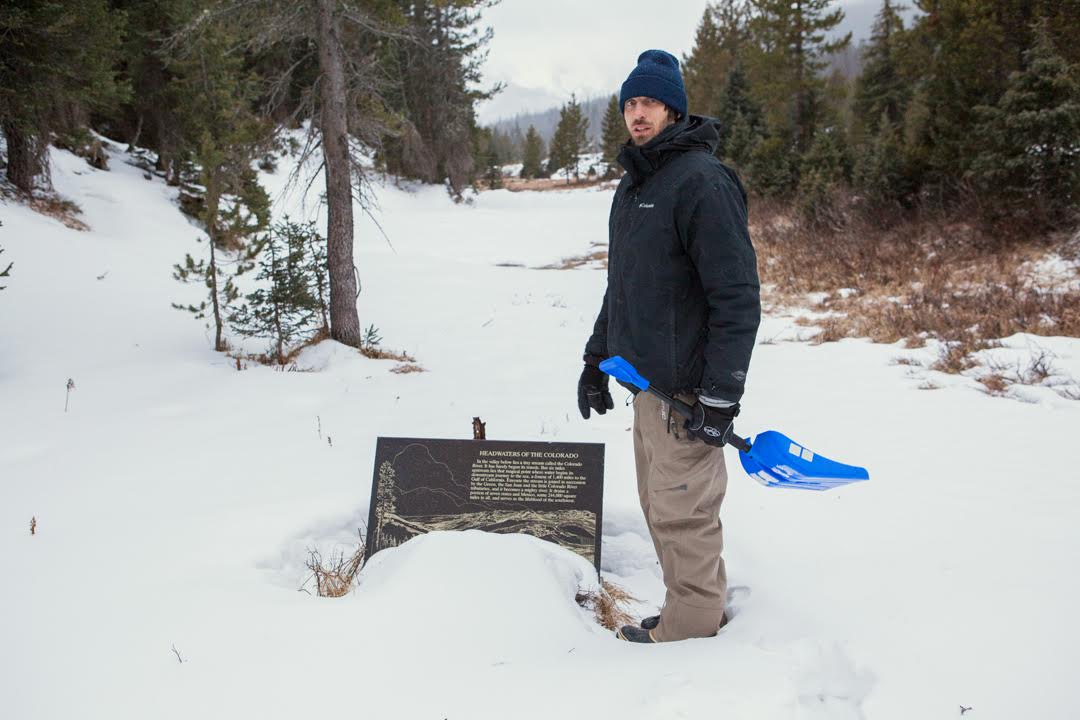
by DGR News Service | Oct 29, 2017 | Listening to the Land
Featured image by Michelle McCarron
Editor’s note: This is the latest installment from Will Falk as he follows the Colorado River from headwaters to delta, before heading to court to argue for the Colorado River to be recognized as having inherent rights. More details on the lawsuit are here. The index of dispatches is here.
by Will Falk / Deep Green Resistance Southwest Coalition
To truly understand someone, you must begin at her birth. So, Michelle and I spent the last two days looking for the Colorado River’s headwaters in the cold and snow above La Poudre Pass on the north edge of Rocky Mountain National Park. The pass is accessible by Long Draw Road off of Colorado Highway 14. Long Draw Road is an unpaved, winding, pot-holed trek that takes you fourteen miles through pine and fir forests and past the frigid Long Draw Reservoir before ending abruptly in a willow’d flat.
We found the road covered in an inch of frosty mud which required slow speeds to avoid sliding into roadside ditches. The drive served as a preparatory period in our journey to the Colorado River’s beginnings. The road’s ruggedness and incessant bumps combined with sub-freezing temperatures to ask us if we were serious about seeing the Colorado River’s headwaters. I was worried that Michelle’s ’91 Toyota Previa might struggle up the pass, but the van continued to live up to the Previa model’s cult status.
Long Draw Road foreshadowed the violence we found at the river’s headwaters. Swathes of clearcut forests escorted the road to the pass. The Forest Service must be too lazy to remove single trees from the road as they fall because Forest Service employees had simply chainsawed every tree within fifty-yards to the left and right of the road. About 3 miles from the road’s end, we ran into a long, low dam trapping mountain run-off into Long Draw Reservoir. We expected to find wilderness in La Poudre Pass, so the dam felt like running into a wall in the dark.
The clearcuts, dam, and reservoir are grievous wounds, but none of them are as bad as the Grand Ditch. We walked a quarter-mile from the end of Long Draw Road where we found a sign marking the location of the river’s headwaters. On our way to the sign, we crossed over a 30-feet deep and 30-feet wide ditch pushing water west to east. We were on the west side of the Continental Divide where water naturally flows west. We contemplated what black magic engineers employed to achieve this feat. The ditch was as conspicuous in La Poudre Pass as a scarred-over gouge on a human face.
The Grand Ditch was begun in the late 1880s and dug by mostly Japanese crews armed with hand tools and black powder. It was built to carry water, diverted from the Colorado River’s headwaters, east to growing cities on Colorado’s Front Range. Close to two feet of swift water ran through the ditch. We learned that even before melting snowpack forms the tiny mountain streams identifiable as the Colorado River’s origins, water is stolen from her. Pausing in a half-foot of powder, I wondered whether the water stored here would end up on a Fort Collins golf course or stirred by the fins of a Vaquita porpoise in the Gulf of California.
Study the Colorado River’s birth and you’ll learn she is born from a wild womb formed by heavy winter clouds, tall mountain peaks, and snowpack. But, she emerges from this womb immediately into exploitation. In La Poudre Pass, the young Colorado River tastes the violence that will follow her the rest of her life.
To repost this or other DGR original writings, please contact newsservice@deepgreenresistance.org
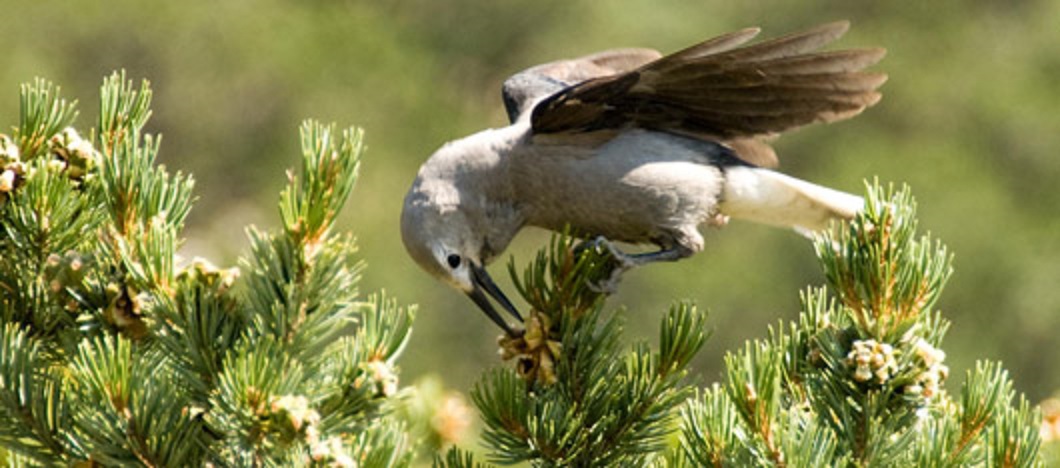
by Deep Green Resistance News Service | Jun 11, 2017 | Biodiversity & Habitat Destruction
by Will Falk / Deep Green Resistance
A windmill blade knocks the head off a Cooper’s hawk interrupting the late afternoon peace in Spring Valley, just outside Ely, Nevada.
The blade tosses the hawk’s body onto yellow gravel the power company spread, over living soil, in circles around their windmills.
The ever-present Great Basin breeze, who usually whispers with a soothing tone through pinyon needles, juniper branches, and sage tops, becomes angry. Grazing cows pause their chewing and look up to consider the scene.
Heads of cheat grass poke through the gravel, only to droop with sorrow for the splayed feathers and twisted wings at their feet. Taller than cheat grass and crowding around the gravel’s edge, crested wheatgrass shakes and shutters with horror in the wind.
The collision’s suddenness and the sickening sound of the blade striking the hawk’s small skull breaks my awareness open with a pop. I seep across the valley floor. I mingle with the wounds on the land and recognize pain in places I previously overlooked. The windmills, the invasive plants, the cows, and the empty scars on the foothills marking pinyon-juniper clearcuts are all evidence of violence.
The gravel at my feet is the remains of stones and boulders that were exploded and crushed, loaded into trucks, and transported to Spring Valley as part of Pattern Energy’s Spring Valley Wind Farm project. Windmill construction means so much involves land clearances, building maintenance roads, and operation of fossil-fuel intensive heavy machinery.
Before the gravel was dumped and the construction project started, the ground I stand on was covered in a complex mosaic of lichens, mosses, microfungi, green algae, and cyanobacteria that biologists call a “biological soil crust.”
Across the Great Basin, biological soil crusts are integral to protecting soil surfaces from erosion. They are also vulnerable to disturbance by construction projects like the one that brought the windmills here. The lichen components of these disturbed crusts can take 245 years to recover. Far worse, soil losses due to erosion following mechanical disturbances can take 5,000 to 10,000 years to naturally reform in arid regions.
The windmills that tower above me fill the air with a buzzing, mechanical sound. Built only four miles from a colony of millions of Mexican free-tailed bats at the Rose Guano Cave, the windmills killed 533 bats in 2013, triple the amount allowed by federal regulations. The majority of these bats are killed by barotrauma. Rapid or excessive air pressure change, produced by windmills, causes internal hemorrhaging. In less abstract language, the bats’ lungs explode.
Both cheatgrass and crested wheatgrass are invasive species. Global shipping routes, which have long been tools of colonialism, brought cheatgrass to North America through contaminated grain seed, straw packing material, and soil used as ballast in ships. Cheatgrass outcompetes native grasses for water and nutrients. It drops seeds in early summer before native grasses and then drys out to become highly flammable.
When wildfires rip through areas cheatgrass has invaded, native grasses are destroyed without seeding. In the fall, after native grasses have burned, cheatgrass seeds germinate and cheatgrass dominance expands. This dominance has been disastrous for the Great Basin. Fire return intervals have gone from between 60-110 years in sagebrush-dominated systems to less than 5 years under cheatgrass dominance.
While cheatgrass was imported by accident, crested wheatgrass was imported from Asia in 1898. By the 1890s, Great Basin rangelands were depleted of water, soil, and economically useful vegetation. Ranchers needed cheap feed for their livestock and crested wheatgrass provided it. It outcompetes native grasses, grows in tight bunches that choke out other species, quickly forms a monoculture, and reduces the variety of plant and wildlife species in places it takes hold. Worst of all, crested wheatgrass supports a destructive ranching industry that should have collapsed decades ago.
Ranching is one of the most ecologically destructive activities in the Great Basin. Livestock grazing depletes water supplies, causes soil erosion, and eliminates the countless trillions of small plants forming the base of the complex food web supporting all life in the region. Ranchers have nearly killed off all the top carnivores on western rangelands and jealously guard their animals against the re-introduction of “unacceptable species” like grizzly bears and wolves.
Ranchers, always searching for new rangeland, encourage government agencies like the Bureau of Land Management (BLM) and the US Forest Service (USFS) to clear-cut forests and remove sagebrush to encourage the growth of graze for their livestock. In the hills north of the wind farm, pinyon pines and junipers lie in mangled piles where they were “chained.”
Chaining is the preferred method for destroying forests here. To chain a forest is to stretch a US Navy battleship anchor chain between two crawler tractors which are then driven parallel to each other while ripping up every living thing in their path.
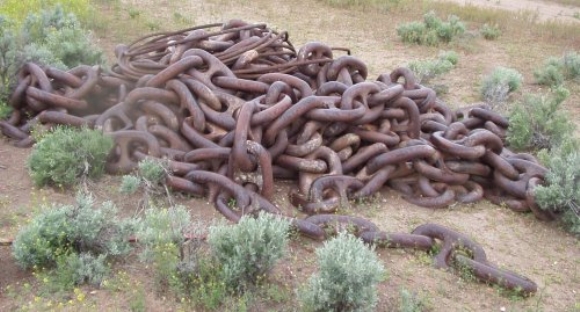
Ship chain used to clear forests. Photo: Wikimedia Commons
Nevada Highway 893 runs to my left along the west side of the valley. If I followed the road north a few miles, I would run into one of the Southern Nevada Water Authority’s (SNWA) test wells. SNWA installed these wells in the preparation of its Clark, Lincoln, and White Pine Counties Groundwater Development Project that would drain Spring Valley of water and, then, transport the water by pipeline to support Las Vegas’ growing population.
Fortunately, the project has been successfully stalled in court by determined grassroots activists. But, if SNWA eventually prevails, Spring Valley will quickly dry up and little life, endemic or invasive, will survive here.
***
The reminders of violence I encounter in Spring Valley reflect global problems. Windmills are a symptom of the dominant culture’s addiction to energy. The roads here will carry you to highways, highways to interstates, and interstates to airports.
There is virtually nowhere left on Earth that is inaccessible to humans with the privilege, power, and desire to go wherever they will. To gain this accessibility, these humans are so thoroughly poisoning the atmosphere with greenhouse gas emissions global temperatures are rising.
Invasive species – cows, cheat grass, crested wheatgrass, European settlers – are colonizers. They each colonize in their own way. The cows replace elk, pronghorn, wolves, and bears. The grasses eliminate natives by hoarding nutrients and water. They reproduce unsustainably and establish monocultures. When that doesn’t work, they burn the natives out. And, the settlers do the same.
The violence of civilized life becomes too obvious to ignore and the land’s pain threatens to overwhelm me. Despair accompanies these moments. When all I see is violence, it is easy to conclude that violence is all there is, all there ever was, and all there ever will be. Claims I’ve heard repeated countless times echo through my mind.
Humans are selfish. This is just what we do. We will kill ourselves, but the planet will recover…eventually. Humans have been butchering each other for centuries and we’ll butcher each other for centuries more if we don’t destroy the world first.
I stand paralyzed under a windmill, with a decapitated hawk at my feet, struggling through my thoughts for who knows how long, when the blue feathers of a pinyon jay catch my eye. At first, it’s the simple beauty of her color that attracts my attention. But, it’s the strangeness of the phenomenon that keeps my attention.
Rows of windmills form the wind farm. I stand under the northernmost row and about one hundred yards separate the rows. The jay lands on a barbed wire fence post about halfway between the row I’m standing under and the first row south of me. Her presence is strange for two reasons. First, pinyon jays prefer to live in pinyon-juniper forests and there are no trees for a mile in either direction. Second, pinyon jays are very intelligent, and she must have known that to brave the circling windmill blades is to brave the same death the Cooper’s hawk just experienced or the barotrauma so many bats experience.
The despair I felt a few moments ago is fading. As I approach the jay I see her picking through a pinyon pine cone. She picks deftly at it before she pulls a pine nut from the brown folds of the cone. It’s not until she lifts her head, with the pine nut in her beak, that I understand.
She flew down from the forests, through dangerous windmill blades, to show me a pine nut.
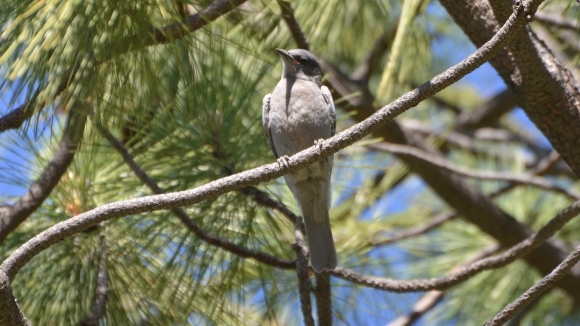
Pinion Jay – Photo: Wikimedia Commons
***
Pine nuts represent the friendship humans and pinyon-juniper forests have shared for thousands of years. Pinyon charcoal and seed coats have been found in the 6,000-year-old Gatecliff Shelter in central Nevada. Pinyon seed coats have been found with 3,000-year-old artifacts in Hogup Cave in northwestern Utah. Many of the Fremont culture’s ruins (circa 1000 AD) in eastern Utah also show pinyon use.
Pine nuts are symbols of true sustainability. I’ve heard many traditional, indigenous people explain that sustainability requires making decisions with the succeeding seven generations in mind. When the health of the seventh future generation guides your relationship with the land, overpopulation, drawdown, pollution, and most forms of extraction become unthinkable. European settlers arrived to find indigenous peoples in the Great Basin, like so many indigenous peoples around the world, living in cultures that existed for centuries in balance with the land.
And, the pine nut made these cultures possible.
The Washoe, Paiute, and Shoshone all developed cultures centered on pine nuts. Pinyon pine expert, Ronald Lanner notes, “Just as life on the plains was fitted to the habits of the buffalo, life in the Great Basin was fitted to the homely, thin-shelled nut of the singleleaf pinyon.” Pinyons give their nuts freely and harvesting them involves no damage to the trees. In fact, pine nuts are seeds. Animals who collect and gather the seeds – like pinyon jays, rats, mice, and humans – help the trees reproduce.
It’s a beautiful relationship: pinyon pines offer animals food, and animals offer pinyon pines regeneration. At a time when the survival of life on Earth depends upon humans embracing their role as animals, the relationship the Washoe, Paiute, and Shoshone built with pinyon pines serves as a model for the world.
Relying on the research of American Museum of Natural History archaeologist David Hurst Thomas, Lanner describes the central role the annual pinyon festival played in Western Shoshone life. He writes, “…when pinyon harvest time arrived, Shoshone bands would come together at a prearranged site. There they would harvest nuts, conduct communal rabbit drives, and hold an annual festival. The pinyon festival was the social highlight of the year and was often attended by several hundred people. At night…there was dancing…There was gambling among men and courting among the young. Marriages were arranged and sexual liaisons conducted.”
Pine nut crops, like all natural processes, are subject to variation. There are good yields and bad yields. Human cultures dependent on the land are constantly confronted with a choice. Either humans can tighten their belts and reduce their populations voluntarily. Or, they can exploit the land, stealing resources from the future to meet the needs of the present.
Lanner describes how Western Shoshone sustainability was maintained, “…the pinyon festival was used as an opportunity for regulating the future size and distribution of Shoshone populations. If at the festival the intelligence from all areas foretold a failure of next year’s crop, then measures could be taken to avoid mass starvation…Births could be limited by sexual abstinence or abortion. One or more twins could be killed at birth, as could illegitimate children…The sick and the old could be abandoned. A widow might be killed and buried beside her husband.”
Some of these measures may seem harsh to us today. But, when we consider the violence necessary to sustain today’s civilized, human populations, we will realize that some of these difficult decisions are what true sustainability looks like. Killing a twin or abandoning the sick is small violence compared to the mass violence of deforestation, anthropogenic desertification, and climate change.
***
The pinyon jay in Spring Valley shows me both a pine nut and the history of human sustainability. Even though Spring Valley, with the rest of the world, currently reflects too much human violence, the vast majority of human history reflects true sustainability. Modern humans have existed for 200,000 years. For the vast majority of that time, most of us lived in cultures similar to the Western Shoshone. We must not forget where we come from.
Meanwhile, ecological collapse intensifies. Violence against the natural world is so pervasive it must be considered a war. Perceiving this war hurts. The pain offers us two choices: endurance or cure. Either the pain is inevitable, an unavoidable fact of life that must be endured. Or, the cause of the pain can be treated and healed.
The pervasiveness of violence tempts us to conclude that it is inevitable. When everywhere we look, we are met with human destruction, it is easy to believe that humans are inherently destructive. This is one reason why the dominant culture destroys the natural world so zealously. If violence is inevitable, there is no reason to stop it.
This is also why the dominant culture works to destroy those non-humans we’ve formed ancient friendships with. If the dominant culture eradicates bison, it destroys our memory of how to live sustainably on the Great Plains. If the dominant culture eradicates salmon, it destroys our memory of how to live sustainably in the Pacific Northwest. If the dominant culture eradicates pinyon-juniper forests, it destroys our memory of how to live sustainably in the Great Basin.
There is a war being waged on the natural world and wars are fought with weapons. The pinyon jay brings me a weapon against the despair I feel recognizing pervasive violence in Spring Valley. She shows me that the violence is not inevitable. She shows me the path to true sustainability, and in doing so, shows me the path to peace.
To learn more about the effort to protect pinyon-juniper forests, go to Pinyon Juniper Alliance. You can contact the Alliance here.
To repost this or other DGR original writings, please contact newsservice@deepgreenresistance.org
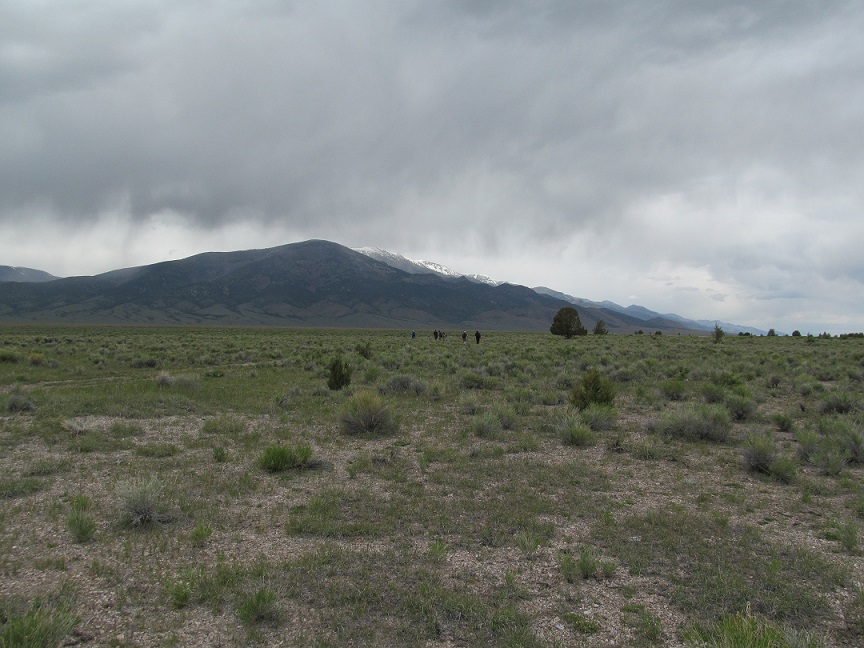
by Deep Green Resistance News Service | Apr 29, 2017 | Education
by Max Wilbert / Deep Green Resistance Great Basin
As a kid, I pictured Nevada as a wasteland of sand and cacti. Today, I know better.
For the past five years, I’ve been packing up my truck every spring and taking a long day to drive to eastern Nevada to bask in the glory of one of the least densely-populated areas of the United States.
The broad valleys never fail to stun me, but most amazing are the mountains, limestone peaks arcing into the sky. Springs and creeks flowing from the hills support rich riparian zones and bring in birds and other wildlife from miles around. Antelope, deer, elk, and wild horses cross the valleys or stick to forested patches. This region is lush, biodiverse, and beautiful.
It’s also under threat. Across eastern Nevada, the Southern Nevada Water Authority seeks to build dozens of massive groundwater wells and pump almost every drop of water south to feed Las Vegas developments. The project has been a battle between locals and developers from Vegas for decades, and still drags on.
Another major threat is felling pinyon pine and juniper forests across not just this region, but the entire intermountain west. Ranchers have been doing this for decades to remove pesky trees getting in the way of their grass—and more importantly, their profit. As overgrazing continues to desertify Nevada—it’ll look like Iraq in another 100 years—removing trees allows ranchers to maintain the illusion that overstocking can continue indefinitely.
Countless people, including myself, are mobilizing to fight like hell for this land, this water, and these forests. We aim to stop these destructive projects by exposing their true nature and—if necessary—standing in their way.
There is a lot more to these stories, but I don’t have time to share it all here. Instead, I’d like to invite you to join myself and other community members, indigenous people, activists, ecologists, photographers, and families for the fifth annual Sacred Water, Sacred Forests Camp.
The camp takes place over Memorial Day weekend, May 27 to 29, near the town of Ely and Great Basin National Park. If you’re interested in attending, you can RSVP on the Facebook event page or by emailing greatbasin@deepgreenresistance.org.
I hope to be able to introduce you to this important, imperiled area in a few weeks.
—
Max Wilbert is a community organizer based in western Oregon who considers Nevada a second home.




